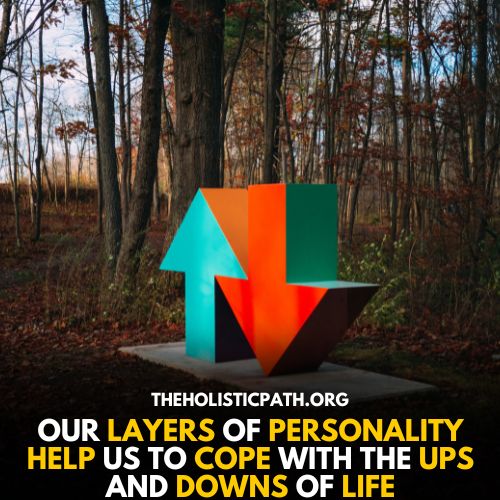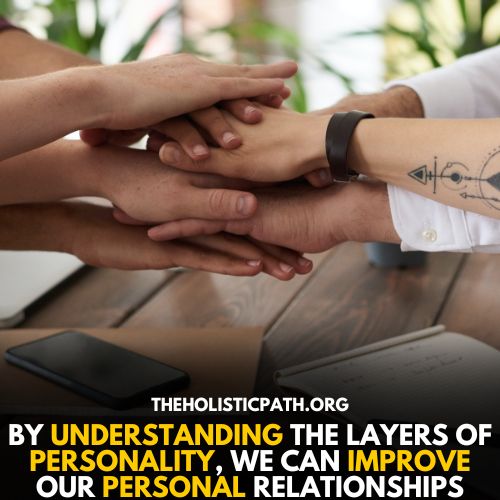Most people think of their personality as a single, static entity: something that is the same from day to day and year to year. But research shows that this view is far too simplistic. In reality, our personalities are more like onion skins: there are many layers, and each one is affected by the ones below it.
In this article, we will explore the layers of personality; the Big Five personality traits, and how your childhood affects your adult personality. We will also discuss how to deal with difficult personalities.
What Are Personality Layers And Why Do They Matter
Everyone has layers to their personality – it’s what makes us complex and interesting individuals. Different people will have different layers, and some layers will be more prominent than others. But why do these layers exist, and why do they matter?

One reason why we have layers to our personalities is that we’re constantly evolving. As we experience new things, meet new people, and grow as individuals, our layers change and adapt. This can be a positive or negative thing – for example, someone who was once shy and introverted might become more confident and extroverted after spending time around other people.
Or, someone who was once carefree might become more guarded after going through a traumatic experience. Our layers help us to cope with the ups and downs of life, and they play an important role in our mental health.
Another reason why layers matter is because they can help us to understand other people. By getting to know someone’s layers, we can better understand their motivations, triggers, and how they react in different situations.
This can be helpful in both personal relationships and professional interactions. For example, if you know that your boss is struggling with something at home, you might be able to cut them some slack if they’re snapping at you more than usual.

Layers are an essential part of who we are as human beings. They make us complex, fascinating creatures – so it’s no wonder that they matter so much!
The Three Main Layers Of Personality
One’s personality can be broken down into three layers – the Driver, the Organizer, and the Thinker. The Driver is the outermost layer and is responsible for one’s actions and behaviors. The Organizer is the middle layer and helps to direct one’s thoughts and emotions. The Thinker is the innermost layer and encompasses one’s values, beliefs, and goals.
Each of these layers interacts with each other to create a person’s overall personality.
1. The Driver Layer Of Personality
The Driver is the part of the personality that is most concerned with action. It is impulsive and driven by immediate needs and desires. The Driver is often associated with the id in Freudian psychology. An example of the Driver in action would be if someone spontaneously decided to quit their job because they were unhappy.
2. The Organiser Layer Of Personality
The Organizer is the part of the personality that helps to direct one’s thoughts and emotions. It is rational and organized, always seeking to find meaning in everything. The Organizer is often associated with the ego in Freudian psychology.
An example of the Organizer at work would be if someone was able to control their anger after a long day at work by taking a deep breath and counting to ten.
3. The Thinker Layer Of Personality
The Thinker is the part of the personality that encompasses one’s values, beliefs, and goals. It is introspective and always searching for truth. The Thinker is often associated with the superego in Freudian psychology.
An example of the Thinker in action would be if someone decided to go back to school to get a higher education even though it would be difficult.
The Big Five Personality Traits
It’s no secret that people are complex creatures. Just when you think you have someone figured out, they go and do something that totally throws you for a loop. The thing is, we’re all like that to some extent. It’s just part of being human.
But why? Well, one reason is that we all have different layers to our personalities. You might act one way around your family, another way around your friends, and yet another way at work. It all depends on the situation.
But what if we looked at personality a little differently? What if, instead of looking at the different layers, we looked at the big picture? That’s where the Big Five personality traits come in. These five traits are openness, conscientiousness, extraversion, agreeableness, and neuroticism.
They are universal traits that can be found in every culture. They help to give us a better understanding of human behavior. So, let’s take a closer look at each one.
1. Openness
Openness refers to how open-minded someone is. People who are high in openness are always exploring new ideas and trying new things. They’re open to change and tend to be more creative than other people.
On the other hand, people who are low in openness are more resistant to change and prefer to stick with the familiar. They’re usually less creative than those who are high in openness.

2. Conscientiousness
Conscientiousness is all about self-discipline and self-control. People who are high in conscientiousness are organized and goal-oriented. They’re good at following rules and meeting deadlines.
On the other hand, people who are low in conscientiousness tend to be more spontaneous and carefree. They’re not as focused or driven as those who are high in conscientiousness.
3. Extraversion
Extraversion is all about how outgoing someone is. People who are high in extraversion tend to be energetic and sociable. They enjoy being around other people and tend to seek out social interaction.
On the other hand, people who are low in extraversion tend to be more introverted and reserved. They prefer solitary activities. They don’t require as much social interaction as those who are high in extraversion.
4. Agreeableness
Agreeableness is all about how cooperative someone is. People who are high in agreeableness are compassionate and caring. They’re good team players and often put the needs of others before their own.
On the other hand, people who are low in agreeableness tend to be more competitive and individualistic. They’re less likely to cooperate with others and may be seen as cold or insensitive.
5. Neuroticism
Finally, neuroticism is all about how prone someone is to anxiety or stress. People who are high in neuroticism tend to be easily agitated or upset by things that happen around them.
On the other hand, people who score low on neuroticism tend to be more emotionally stable and react calmly to stressful situations.
How Your Childhood Affects Your Adult Personality
Childhood is often thought of as a time of innocence and playfulness. But it’s also a time when we start to develop the layers of our personalities. Our upbringing, family life, and the people we interact with all help shape who we are as adults.

For example, the way we were treated by our caregivers often shapes how we view ourselves and interact with others. If we experienced consistent love and support, we’re more likely to develop a healthy sense of self-worth.
On the other hand, if we were neglected or treated harshly, we may struggle with self-doubt and poor self-esteem. Our early relationships also play a role in shaping our personalities. If we had positive relationships with our parents and siblings, we’re more likely to be outgoing and confident.
But if those relationships were fraught with conflict, we may be more shy or withdrawn as adults. Even seemingly small things like the way we were disciplined can have an impact. For instance, if we were spanked as children, we may be more likely to resort to violence as adults.
Of course, not every aspect of our personality is determined by our childhood experiences. But it’s safe to say that they lay the foundation for who we become as adults.
How To Access Each Layer Of Personality
There are many layers to every person’s personality, and accessing them can be difficult. However, there are some methods you can use to get to know yourself on a deeper level.
- One way is to keep a journal. Writing about your day-to-day experiences can help you to identify patterns and uncover hidden aspects of your personality.
- Another method is to speak with a therapist or counselor. Talking openly and honestly about your thoughts and feelings can give you a better understanding of yourself.
- Spending time alone in reflection can also be helpful. By taking some time to introspect, you may discover things about yourself that you were previously unaware of. Ultimately, getting to know your layers of personality is an ongoing process.
However, by using these methods, you can begin to peel back the layers and get a better sense of who you are.
What Each Layer Reveals About A Person
Everyone has layers to their personality – those aspects of ourselves that we show to the world, and those that we keep hidden away. Each layer reveals something different about a person, and often, the more layers someone has, the more complex they are. Here are some examples of what each layer of personality can reveal about a person:
- The outermost layer is what we show to the world. This is our “public face” – the side of ourselves that we put forward when we’re meeting new people or trying to make a good impression. This layer can reveal things like our confidence level, our social skills, and how outgoing we are.
- The second layer is what we show to our close friends and family. This is the side of ourselves that is more relaxed and comfortable – the people who know us best see this side most often. This layer can reveal things like our sense of humor, our values and beliefs, and how emotional we are.
- The third layer is what we show to only a few select people – usually those who we are very close or feels safe with. This is the most intimate side of ourselves, the part that we rarely let anyone see. This layer can reveal things like our insecurities, our fears, and our deepest desires.
Examples Of How Each Layer Can Manifest In Someone’s Life
Layers of personality – is what make us unique and interesting individuals. However, sometimes these layers can become a bit disordered, manifesting in negative ways in our lives. For example, someone who is normally quite confident may start to doubt themselves when faced with a new challenge.
Or, someone who is usually easygoing may become irritable and short-tempered when under a lot of stress. The good news is that, even though our layers can get jumbled up from time to time, we always have the power to straighten them out again.
By taking the time to get to know ourselves better, we can learn which situations tend to trigger negative reactions and take steps to avoid them. With a little effort, we can all live more balanced and fulfilling lives.
How Can You Determine Your Personality Layers
How can you determine your own layers of personality? Here are some examples:
- Think about how you act around your family, compared to your friends or colleagues. Do you tend to be more relaxed and informal with family, or more reserved and formal?
- Think about how you act in social situations versus when you’re by yourself. Do you tend to be more outgoing when you’re with a group, or do you prefer your own company?
- Think about how you act under stress. Are you the type of person who gets frazzled and flustered, or do you stay calm and collected?
These are just a few examples – everyone’s layers of personality are unique to them. By taking some time to think about how you act in different situations, you can start to get a sense of your own layers.
What Are The Benefits Of Understanding Your Personality Layers
There are many benefits to understanding your personality layers. When you know which layers dominate your personality, you can make choices that lead to a more balanced and fulfilling life. Here are some examples of how understanding your personality layers can be helpful:
- You can learn to accept yourself for who you are.
- You can focus on developing the parts of your personality that are underdeveloped.
- You can learn to better relate to other people.
- You can gain insight into why you behave the way you do in certain situations.
- You can find out what career paths might be a good fit for your personality type.
- You can discover which areas of your life need more attention.
Understanding your personality layers is a valuable tool for personal growth. By learning about the different layers of your personality, you can make choices that will lead to a more fulfilling and balanced life.
What Should You Do If You Don’t Like One Or More Of Your Layers Of Personality
Everyone has layers of personality – the outermost layer being the one that people see most often, and the inner layers being more hidden. Sometimes, people can be surprised by how different they are on the inside than they appear on the outside. Other times, people might not like some of their layers of personality. If this is the case, there are a few things that can be done.
- Talk to someone who knows you well: This person can help you to understand why you don’t like certain aspects of your personality, and can also offer advice on how to change or accept them.
- Do some soul-searching: This can involve introspection, journaling, or therapy. It’s important to get to the root of why you don’t like certain parts of yourself before trying to change them.
- Make a change: If there’s something about your personality that you really don’t like, it might be possible to change it. However, this isn’t always easy, and it’s important to be realistic about what can be changed.
- Acceptance: In some cases, the best thing to do is simply accept that there are parts of your personality that you don’t like. Everyone has flaws, and accepting them is an important part of self-love.
How To Understand The Personality Layer Of Others
When we first meet someone, we usually only see the surface layers of their personality. It takes time to get to know someone and to see the deeper layers of their personality. However, there are some ways that you can start to understand the personality layers of others.
One way to do this is to pay attention to how they interact with different people and in different situations. Do they have a wide range of friends or do they tend to stick to just a few close friends? Do they act differently around their family than they do around their friends? How do they respond to stress or difficult situations?
By observing how someone interacts with others, you can start to get a sense of their underlying personality.
Another way to understand the personality layers of others is to ask them questions about themselves. Open-ended questions can be particularly helpful in this regard. For example, you could ask them about their childhood, their hopes, and dreams for the future, or what motivates them in life.
Asking questions will help you to understand not only what somebody does on a day-to-day basis, but also why they do it.
Understanding the layers of somebody’s personality can be challenging, but it’s worth taking the time to do so. After all, the more we understand about others, the better we can connect with them.
How To Use Knowledge Of Personality Layers To Improve Personal Relationships
Whenever we interact with someone, we are constantly trying to read them and figure out what kind of person they are. We do this by looking at their body language, tone of voice, and the words they use. This process is known as “reading people.”
But what if we could go even deeper? What if we could really understand the layers of personality that make up each individual?

By understanding the layers of personality, we can improve our personal relationships in a number of ways. For example, we can better understand why someone acts the way they do.
We can also learn to communicate more effectively with them. This can also lead us to learn how to create a more harmonious relationship with them.
How Can You Determine Someone’s Layer Of Personality
There are a few different ways that you can determine someone’s layer of personality.
- Pay attention to their body language. Are they constantly crossing their arms or legs, or do they tend to open up and take up space? This can give you clues about how comfortable they are with others and whether they’re guarded.
- Listen to the way they speak. Do they use a lot of flowery languages or are they more direct? This can give you an indication of how they see themselves and whether they’re trying to impress others.
- Notice the way they interact with others. Are they always the life of the party or do they tend to stay in the background? This can give you an idea of how outgoing they are and whether they prefer large or small groups.
By paying attention to these cues, you can start to get a sense of someone’s layers of personality. And, the more you get to know them, the more layers you’ll uncover.
How Can You Tell What Layer Someone Is Operating From
How can you tell what layer someone is operating from? Well, there are a few giveaway signs. For instance, people who are highly self-aware and in touch with their emotions are likely to be operating from the top layers.
Conversely, people who tend to be more disconnected from their emotions and less self-aware are likely to be operating from the lower layers. Here are a few more specific examples:
- Top layers: people who are able to effectively manage their emotions, set boundaries, and have a strong sense of self-awareness.
- Middle layers: people who may struggle with emotional regulation or managing stress, but who still have a basic sense of self-awareness.
- Bottom layers: people who tend to be highly reactive and impulsive, with little awareness of their own emotions or the impact of their actions on others.
So, next time you’re trying to figure out what layer someone is operating from, pay attention to how they interact with the world around them. If they seem highly attuned to their own emotions and the emotions of others, chances are they’re operating from one of the top layers.
But if they seem disconnected and unengaged, they’re probably operating from one of the lower layers.
How Can You Work With People Who Have Different Layers Of Personality
There are all sorts of different layers to every personality. Some people are easy to get along with because their layers are all on the surface. But others have layers that are hidden deep down, which can make them more challenging to work with.

There are a few things you can do to try and reach those deeper layers:
- Show genuine interest in the person. Ask questions about their life, their interests, their opinions, etc. The more you show that you care, the more likely they are to open up to you.
- Be accepting. It’s important to accept people for who they are, even if they’re not exactly like you. Everyone is different, and that’s what makes life interesting.
- Try to understand where they’re coming from. Everyone has their own perspective, and if you can understand where someone is coming from, it will be easier to work with them.
- Be patient. Some people may take longer to open up or may not open up as much as you would like. It’s important to be patient and respectful of their personal space.
- Communicate clearly. It’s important to communicate openly and honestly with someone when you’re working with them. This will help avoid misunderstandings and help you work together more effectively.
- Pay attention to body language. Often, body language can be more telling than words. If you’re not sure how someone is feeling, pay attention to their body language and see if you can pick up on any cues.
- Don’t take it personally. It can be easy to take things personally when you’re working with someone whose layers of personality are different from your own, but it’s important to remember that it’s not about you. They’re just wired differently, and that’s okay! If you can keep that in mind, it’ll be a lot easier to stay calm and focused when working together.
If you can manage to reach the deeper layers of someone’s personality, you’ll often find that they’re much more than meets the eye. And that can make for a much more enjoyable and productive working relationship.
How To Deal With Difficult Personalities
It’s pretty much inevitable that you’ll have to deal with a difficult personality at some point in your life. Maybe it’s a coworker who is always creating drama, or a family member who is always putting you down.
Whatever the case may be, it’s important to understand that there are layers to every personality. Often, the difficulties we experience with others stem from our own unresolved issues.
If you find yourself struggling to deal with a difficult personality, here are some tips that might help:
- Try to understand where they’re coming from. What might be causing them to act out in this way?
- Don’t take their behavior personally. It’s not about you, it’s about them.
- Set boundaries and stick to them. You don’t have to put up with their crap just because they’re related to you or work with you.
- Focus on the positive. What do you like about this person, despite their challenges? Try to focus on those things, and let go of the rest.
Dealing with difficult personalities can be challenging, but it’s important to remember that we all have our own layers – and often, the best way to deal with someone else’s challenges is by working on our own.
Conclusion
So there you have it – a brief overview of the layers of personality. As you can see, there are a lot of complexities involved in understanding the human personality. However, by breaking it down into different layers, we can start to get a better understanding of how it all works.
Hopefully, this has given you a better understanding of the layers of personality and how they work together to create our unique sense of self.
